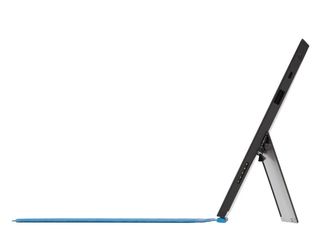Design brilliance
By now, you may well have seen Microsoft's ingenious workaround to combat the inevitable problem of a tablet versus a laptop: how do you keep the screen at a position where it can be viewed whilst you type or watch a movie?
In the Surface's case, the answer is a clever little kick stand built in such a way that it sits flush with the back. This puts the screen at a 100-degree angle to the keyboard, and when working on a desk or train table we found it an excellent compromise.

We do like the kickstand - but it requires a flat surface to be at its most useful
The design gets a little annoying when used on knees say on a train without the luxury of a table. Because it's inherently flexible, when you start typing the screen bobs back and forth, and the hard lines of the kick stand do dig into your legs a little. We'd also like a little more flexibility over the angle taller people may want it to be a bit flatter than it is, for example.
But we don't want to leave the impression that it's a poorly designed. It isn't. As a whole, we found typing on the Surface a massive improvement over rival tablets, and have already typed 10,000 words on it, so Microsoft has got something right.
We're tempted to say the screen is a benefit over previous-generation laptops as well, but this comes with more caveats.
At 10.6in, you'll certainly notice the difference if you're shifting away from a 13in, 14in or 15in laptop, even if a 1,366 x 768 resolution may be similar. The reason why it might be considered a benefit is the quality of the screen itself: it's brilliantly bright and the colour accuracy is as good as you'll find on a mobile device. Photos leap from the screen.
We're also pleased to see that Microsoft hasn't jettisoned connectivity for the sake of sleekness. On the right-hand side there's a USB 2 port, which we can almost guarantee you'll find yourself using at some point.
Theoretically, pretty much any device that works with Windows 7 should be supported by the Surface, and in the majority of our tests this proved true. Only two products provide unusable: a cheap HP all-in-one and an old Fujitsu scanner (see a full list of compatible products).
A micro-HDMI port could occasionally prove useful as well, especially as Microsoft is selling adapters for VGA and full HDMI connections. Plus, you can actually extend your desktop onto a second display; not an option with the iPad.
The final piece of design ingenuity we'll salute is hidden from view, but nevertheless handy: the fact that the Surface includes two MIMO aerials, helping to ensure excellent wireless performance in our tests. As you'd expect, it supports 802.11n, while Bluetooth 4 support is a bonus.
Tim Danton is editor-in-chief of PC Pro, the UK's biggest selling IT monthly magazine. He specialises in reviews of laptops, desktop PCs and monitors, and is also author of a book called The Computers That Made Britain.
You can contact Tim directly at editor@pcpro.co.uk.

